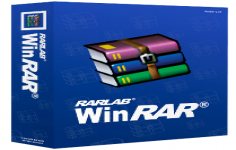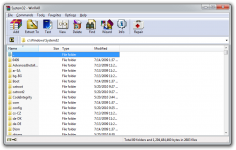 WinRAR 5.70 64-bit for PC Windows
WinRAR 5.70 64-bit for PC Windows
RARLab - ( Shareware)
The very popular WinRAR compress any file or folder offering the possibility to protect or to recover them in case of necessity.
WinRAR is a reference in the field of archiving data compression utilities. Based on RAR compression algorithm, it can significantly reduce the size of the documents.
WinRAR is very useful when it comes to open its archives in case the user does not have this software because it can create self-extracting archives.
WinRAR integrates with Windows Explorer and allows to compress and decompress files from the context menu. For mainstream users, this feature may be sufficient, but WinRAR also includes more advanced features such as protection of archives by creating recovery volumes possibilities, adding passwords, test archived files or a module for benchmarking test performance by compressing the computer. The encryption uses the AES (Advanced Encryption Standard ) method with a key of 128 bits.
The application is also able to repair a damaged archive when a network transfer was not completed correctly or the storage medium is faulty. But the program is not limited to RAR and ZIP formats because it allows you to view and extract the contents of archives using less common formats such as ACE , 7 -ZIP , CAB , TAR , ISO, GZIP and BZ2 by instance.
- Title:
- WinRAR 5.70 64-bit for PC Windows
- File Size:
- 3.0 MB
- Requirements:
- Windows XP 64-bit / Vista 64-bit / Windows 7 64-bit / Windows 8 64-bit / Windows 10 / Windows 10 64-bit
- Language:
- en-us
- License:
- Shareware
- Date Added:
- 26 Feb 2019
- Publisher:
- RARLab
- Homepage:
- http://www.rarsoft.com/
- MD5 Checksum:
- 85839254AB19D966618C4A0A4EEE5A35
1. "Files to process" option on "Time" page of archiving dialog
allows to choose files based on modification, creation or last access
file time. Previously it was possible for modification time only.
2. Command line -ta, -tb, -tn, -to switches accept 'm', 'c' and 'a'
modifiers after the switch name. So file time conditions can include
not only the file modification time as in previous versions,
but also creation and last access time.
Such switch can include multiple modifiers to set the same date
for all specified times. For example, -tamc20190215 will process files
modified and created after 2019-02-15.
New 'o' modifier permits to switch from AND to OR logic,
so -tamco20190215 includes files modified or created after 2019-02-15.
It is also allowed to specify several time filtering switches
with different dates in the same command line, like:
-taco20190201 -tbmo20190210
Switches -ta and -tn also include files matching the specified date
exactly. Switches -tb and -to exclude such files.
3. WinRAR file list can display creation and last access file times
if they are available.
Creation and last access columns are disabled by default and can be
enabled in "Select file list columns" dialog. This dialog is opened
after right clicking on file list column headers or after pressing
"File list/Files/Columns..." button in WinRAR settings.
4. "Double extensions for archives" and "Archives in subfolders"
options on "Files" page of archiving dialog modify behavior of
"Put each file to separate archive" option.
You can switch between archive names in filename.ext.rar
and filename.rar style with "Double extensions for archives".
You can create a separate archive for every file in selected subfolders
or store the entire contents of every selected folder in separate
archive depending on the state of "Archives in subfolders" option.
5. New -ad1 switch can be used when unpacking multiple archives
recursively, such as 'rar x -r -ad1 arc\*.rar'. It creates
a separate folder for files unpacked from each archive,
but unlike already existing -ad switch, it creates such folders
in each archive folder.
6. If context menu "Extract each archive to separate folder" is applied
to archives from different folders in Windows Explorer "Search results",
subfolders with unpacked files are created in each archive folder.
Previous versions created them all in a folder of right clicked archive.
7. New "File list/List style/Checkboxes" option in WinRAR settings
allows to use checkboxes to select file list items.
8. New "File list/Files/Exact sizes" option in WinRAR settings.
If this option is on, file sizes are always displayed in bytes.
If it is off, sizes are rounded up and use units such as KB or MB.
Smaller files can be still displayed in bytes.
9. If several console RAR are started with -ioff switch, PC is turned off
by RAR copy finished last. Previously this switch was processed
by first finished copy.
10. Read and write buffer size is increased for .iso files.
It can help to improve .iso extraction performance in some cases,
such as for network drives.
11. If "Delete archive" option in extraction dialog is applied to a set
of RAR and REV volumes in volname.part# format, WinRAR will delete
REV volumes as well. Previously only RAR volumes were deleted
keeping REV files intact.
12. If "Delete archive" option in extraction dialog is applied to set
of ZIP volumes with .zip.001, .zip.002, .zip.003 extensions,
WinRAR will delete all ZIP volumes. Previously only .zip.001 volume
was deleted for such volume naming scheme.
13. If we unpack arcname.rar using "Extract to arcname\" Explorer context
menu command and "arcname" file already exists, WinRAR shell extension
will propose "Extract to arcname~1\" instead. Previously this context
menu command attempted to create a folder with same name as already
existing file and failed.
14. If we pack a shortcut file with .lnk extension from Explorer context
menu, .lnk file itself is added to archive. Previous versions added
.lnk file target instead of .lnk file.
15. Windows does not allow executables exceeding 4 GB, so WinRAR issues
an error immediately when attempting to create 4 GB or larger
RAR SFX volumes. Previously WinRAR issued such error only after
creating the first RAR volume.
16. Total extraction progress is displayed for 7z multivolume archives.
Accuracy of 7z total extraction progress is improved.
17. "Find" command "Disks and folders" drop down list has been renamed
to "Search area". Additionally to already existing choices,
it includes a new "Selected items" option restricting search
to files and folders selected in WinRAR file list.
18. "Find" command displays the number of found items in status bar.
19. "Diagnostic messages" window displays archive names in a separate
column to provide the better message visibility for lengthy
archive names.
20. Switch -isnd[-] in command line WinRAR mode allows to override
"Enable sound" option in WinRAR settings. Use -isnd to turn sound
notifications on and -isnd- to turn them off.
21. Nadav Grossman from Check Point Software Technologies informed us
about a security vulnerability in UNACEV2.DLL library.
Aforementioned vulnerability makes possible to create files
in arbitrary folders inside or outside of destination folder
when unpacking ACE archives.
WinRAR used this third party library to unpack ACE archives.
UNACEV2.DLL had not been updated since 2005 and we do not have access
to its source code. So we decided to drop ACE archive format support
to protect security of WinRAR users.
We are thankful to Check Point Software Technologies for reporting
this issue.
22. Bugs fixed:
a) console RAR mixed up source and destination file sizes and times
in the overwrite prompt when updating a file in RAR archive
with -o switch;
b) dragging files from 32-bit applications to 64-bit WinRAR window
did not work;
c) WinRAR Shift+Del command applied to a folder could fail to delete
some its subfolders. This command is used to delete files and folders
permanently instead of moving them to Recycle Bin;
d) folder tree panel could not change folders if archived pathnames
started from path separator, such as in archives created by tar tool
with --absolute-names option;
e) if relative "Path=.\somefolder" was specified in SFX comment
and SFX archive needed to elevate privileges when extracting,
it created 'somefolder\somefolder' instead of 'somefolder';
f) commands modifying an existing RAR4 volume reset the volume number
field to 1. While it did not affect extraction, WinRAR displayed
a wrong volume number for such volumes;
g) fixed a crash when reading a comment from a corrupt RAR file;
h) toolbar in "Find" command "Search results" window was not adjusted
to different toolbar icon sizes properly.
Related software
3.2/5 from 71 users

